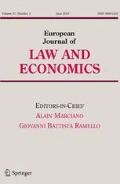Abstract
This paper defines a framework for anticommons analysis based on the fragmentation of property rights. In differentiating between sequential and simultaneous cases of property fragmentation, we describe and assess the equilibria obtained under each scenario. Our model reveals how the private incentives of excluders do not capture the external effects of their decisions. Moreover, our model suggests that the result of underutilization of joint property increases monotonically in both (a) the extent of fragmentation; and (b) the foregone synergies and complementarities between the property fragments. Within this context, we can therefore explore important implications for possible institutional responses to a range of issues raised by the concept of property fragmentation.
Similar content being viewed by others
References
Alchian, A. (1965). "Some Economics of Property Rights." Il Politico. 30, 816–829.
Alchian, A. A. (1977). "Some Economics of Property Rights." In A. A. Alchain (ed.), Economic Forces at Work, Indianapolis: Liberty Press.
Buchanan, J. & Yoon, Y. (2000). "Symmetric Tragedies: Commons and Anticommons Property." Journal of Law and Economics. 43, 1–13.
Coase, R. H. (1960). "The Problem of Social Cost." Journal of Law and Economics. 3, 1–44.
Depoorter, B. & Parisi, F. (2001). "Fair Use and Copyright Protection: A Price Theory Explanation." GMU Law & Economics Working Paper Series No. 01-03.
Eggertsson, T. (1990). "The Role of Transaction Costs and Property Rights in Economic Analysis." European Economic Review. 34, 450–457.
Hardin, G. (1968). "The Tragedy of the Commons." Science. 162, 1243–1248.
Heller, M. A. (1998). "The Tragedy of the Anticommons: Property in the Transition from Marx to Markets." Harvard Law Review. 111, 621–687.
Heller, M. A. (1999). "The Boundaries of Private Property." Yale L.J. 108, 1163–1223.
Heller, M. & Eisenberg, R. (1998). "Can Patents Deter Innovation? The Anticommons in Biomedical Research," 280 Science, excerpted as 'Upstream Patents = Downstream Bottlenecks' in Law Quadrangle Notes. 4.13, 93–97.
Libecap, G. D. & Wiggins, S. (1984). "Contractual Respones to the Common Pool." American Economic Review. 74, 84.
Merrill, T. & Smith, H. (2000). "Optimal Standardization in the Law of Property: The Numerus Clausus Principle." Yale, L.J. 110, 1–70.
Miceli, T. J. (1996). Economics of the Law: Torts, Contracts, Property, Litigation. Oxford: Oxford University Press.
Michelman, F. I. (1968). "Property, Utility and Fairness: Comments on the Ethical Foundations of 'Just Compensation' Law." Harvard Law Review. 80, 1165–1258.
Michelman, F. I. (1982). "Ethics, Economics, and the Law of Property." In J. R. Pennock & J. W. Chapman (eds.), Nomos XXIV: Ethics, Economics and the Law, New York: New York University Press, pp. 3–40.
Parisi, F. (2001). "The Asymmetric Coase Theorem: Dual Remedies for a Unified Property." GMU Law & Economics Working Paper Series No. 01-13.
Parisi, F. (2002). "Entropy in Property." American Journal of Comparative Law. 50, 701–738.
Rose, C. M. (1986). "The Comedy of the Commons: Custom, Commerce, and Inherently Public Property." University of Chicago Law Review. 53, 711–780.
Rose, C. M. (1999). "What Government Can Do for Property." In Mercuro & Samuels (eds.), Fundamental Interrelationships between Government and Property, New York: Elsevier Science Press.
Schulz, N. (2000). "Thoughts on the Nature of Vetoes When Bargaining on Public Projects."Würzburg Economic Papers, 00-17.
Schulz, N., Parisi, F. & Depoorter, B. (2002). "Fragmentation in Property: Towards a General Model." Journal of Institutional and Theoretical Economics. 594-613.
Spengler (1950). "Sequential Integration and Anti-Trust Policy." Journal of Political Economy. 58, 347–352.
Tirole, J. (1993). The Theory of Industrial Organization. Cambridge, MA: MIT Press.
Author information
Authors and Affiliations
Rights and permissions
About this article
Cite this article
Parisi, F., Schulz, N. & Depoorter, B. Simultaneous and Sequential Anticommons. European Journal of Law and Economics 17, 175–190 (2004). https://doi.org/10.1023/B:EJLE.0000014575.00312.15
Issue Date:
DOI: https://doi.org/10.1023/B:EJLE.0000014575.00312.15




